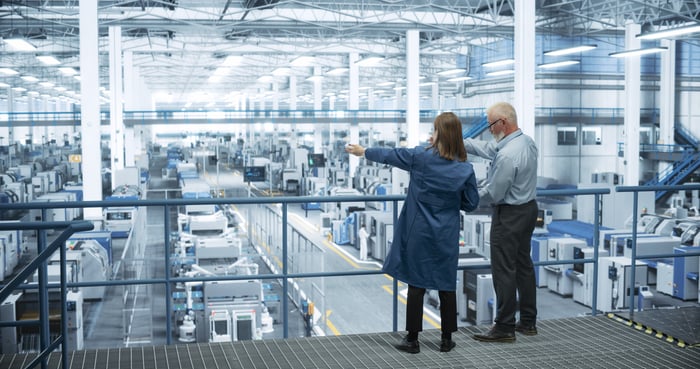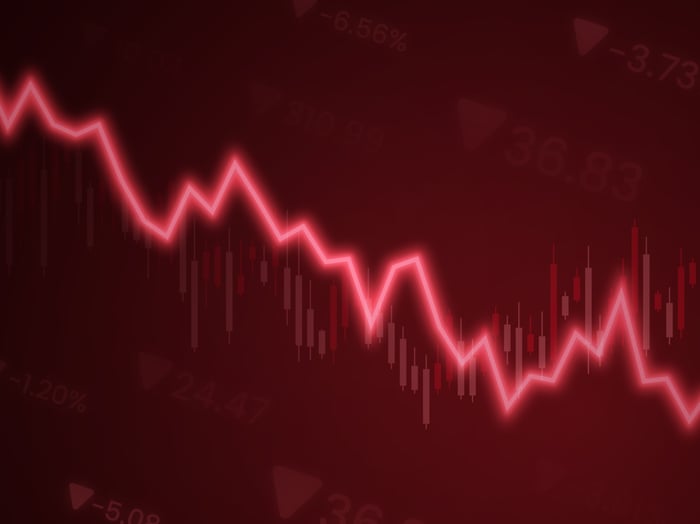But it doesn’t come without some significant risks for investors.
Global spending on artificial intelligence (AI) is set to reach $1.5 trillion this year, according to estimates from Gartner. Even with the huge amount businesses and tech companies are already spending, that number is forecast to climb even further well into the future. The analysts at Gartner expect total spending to hit $2 trillion in 2026. Many analysts see total spending climbing through the end of the decade in order to take advantage of the massive opportunity and promises of generative AI.
One company managed to build a massive $10 billion business out of demand for artificial intelligence compute in just a few years, and it expects to capture a significant amount of market share over the next few years. In fact, management said it expects that $10 billion in annual sales to grow to $144 billion in sales within five years. And it has the contracts to back it up.

Image source: Getty Images.
The massive opportunity ahead
A handful of companies are rapidly building out data centers and leasing space and equipment in order to meet the demand of tech companies training and using large language models. Some contracts from companies like OpenAI and Anthropic, two leading LLM developers, are worth tens of billions of dollars per year. And the biggest cloud computing platforms — owned by Amazon (AMZN -0.84%), Microsoft (MSFT -0.64%), and Alphabet (GOOG -0.53%) (GOOGL -0.56%) — are unable to keep up with the growing demand.
As AI companies look to diversify their compute providers, Oracle (ORCL -5.55%) has emerged as a strong alternative with excellent networking capabilities and competitive pricing. However, its Oracle Cloud Infrastructure (OCI) is lacking in scale relative to the three market leaders. That didn’t stop OpenAI from committing $300 billion to Oracle’s cloud business over five years starting in 2027.
As a result, Oracle reported a huge increase in its backlog of remaining performance obligations. The amount stood at $455 billion as of the end of the company’s first quarter, up from $137 billion at the end of the fourth quarter. While $300 billion of that is tied to OpenAI, Oracle added another $18 billion in contracts on top of that.
And management expects to sign additional contracts in the near future. It said OCI’s remaining performance obligations will likely exceed $500 billion by the end of the current quarter.
If management succeeds in growing OCI from $10 billion to $144 billion over the next five years, it’ll end the decade with a cloud business similar in size to Alphabet’s, based on current growth rates. If it can manage to earn similar operating margins as the three big providers today (20% to 37%), it could produce a huge boost to its existing earnings.
While management notes it already has the backlog to support its revenue outlook, it’s important to consider the significant risks that come with investing in Oracle stock right now.
The future is not guaranteed
Oracle burned $5.9 billion in cash over the past 12 months as it expanded OCI capacity. It took on $27 billion worth of debt over the past year, and it now holds $111 billion of debt on its balance sheet. It’ll have to take on more debt and burn more cash to build out the capacity needed to meet demand for its cloud computing business.
To put things in perspective, Microsoft is committing to $30 billion in capital expenditures for the current quarter, and it’ll likely maintain that pace throughout the year. Amazon expects to spend over $100 billion in 2025, mostly on additional compute capacity. Alphabet updated its target spend to $85 billion for the year, as demand for its cloud infrastructure continues to outstrip supply.
They all have significant backlogs, but none is as big as Oracle’s is now. Oracle plans to spend $35 billion this year, with OCI revenue of $18 billion.
Meanwhile, its three biggest competitors are producing strong positive free cash flow thanks to the fact that they already have large, established cloud businesses and massive businesses outside of cloud computing. Oracle’s legacy software business doesn’t generate nearly enough cash to keep up with the demand for AI compute.
But it’s not just the financing risk Oracle faces. It also takes on the risk of a long-term contract with OpenAI. The generative AI leader has committed to spending $30 billion on Oracle’s compute starting in 2027 and ramping up from there. But the company itself is only bringing in $13 billion in revenue this year, according to its CFO’s outlook. It’s also committed to spending $10 billion with Broadcom, not to mention its existing cloud computing deals with Microsoft and Alphabet.
It’s also unclear how profitable the OpenAI deal will be if it comes to full fruition. Oracle must have offered very attractive pricing relative to its larger competitors to attract such a big commitment. That could result in a significantly worse margin profile relative to Amazon, Microsoft, and Alphabet.
Nonetheless, shares of Oracle have now skyrocketed in price, reaching a forward PE ratio of 45 based on estimates for fiscal 2026. That’s far higher than its larger cloud competitors, making the stock a much riskier investment. If Oracle can execute, build the capacity it needs, and OpenAI holds up its end of the deal, it could be a huge winner over the next five years. But the other three cloud computing providers’ stocks look like much better values with much less risk right now.



















